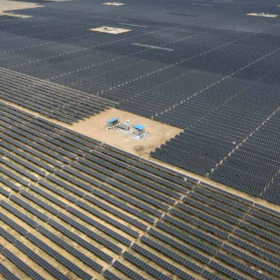From pv magazine 07/2021
A key outcome of Gautham Ram’s recent research on where solar intersects with EVs was a collaboration with industry to build a bidirectional vehicle-to-grid (V2G) charger. Importantly, the charger is powered by solar panels using smart-charging algorithms. Ram started as an assistant professor at TU Delft in 2019, and said academia’s opportunities continue to be exciting.
“As an academic, there’s a lot of freedom in exploring areas of interest, not necessarily driven by short-term market forces. I also like teaching and sharing, and I find it to be a huge learning process,” said Ram.
He shared a recent story where a student asked why hybrid car topics were being taught, given the shift to fully electric EVs. “This caused a personal reckoning for me,” laughed Ram. “I hadn’t thought about it fully, but we can easily see a need for hybrid vehicles long into the future in many parts of the world, despite the popularity of EVs today.“
Smart charging
Ram spent three months at the University of Texas in Austin as part of a researcher exchange between universities. There, he recognized the enormous potential benefits of smart charging EVs across multiple applications, with one battery serving different applications.
If you integrate PV, EVs, and smart charging, selling solar and storage during high prices, as well as performing frequency regulation, it can generate arbitrage plays and revenues, Ram said.
“We looked at what happens when you start stacking the benefits of solar charging: storage, V2G, frequency regulation, and so on. And that’s when we observed that there are very high revenues at play. We didn’t look at who would get the money, we looked at the savings, which were huge,” explained Ram.
“Let’s say you have a bi-directional charger of 10 kW, and you’re charging at 2 kW. You have the potential to increase your power by 8 kW, and decrease your power by 12 kW, by going negative. Compared to connected generators, which are paid to operate to maintain grid balance, batteries in cars respond almost instantaneously. If you see the numbers, you can really meet your primary frequency regulation in any country just by using the cars in the country.”
Ram’s continuing research carried through to a European research project called “Orchestrating smart charging in mass deployment.” This project, with scientific publications still to be published, looked at what happens if the percentage of EVs impacting the grid through smart charging and discharging reaches significant scale – from 20% EV take-up, moving to 40%, 60%, 80%, and the impact on the grid, both with smart charging and without.
Exciting EVs
Ram’s enthusiasm for e-mobility and EVs can’t be missed. However, the key factor for him isn’t only the reduced emissions.
“I think there’s far more to it than emissions. There are far more benefits: The electric drivetrain is three times more efficient than fossil fuel drive trains, simply because you have a battery which is 90% efficient, the motor is 95%, power electronics are in the 90% to 98% range. Whereas, of course, internal combustion engine efficiencies are 20% to 30%,” said Ram, showing details of energy consumption equivalents compiled by the U.S. Department of Energy, where a Tesla Model 3 gets 134 MPGe (miles per gallon equivalent).
“The efficiency, the fact that you get your braking energy back, along with less maintenance and brake pads lasting far longer, no oil changes required … we’re talking 3-5 times improved efficiency, and maintenance costs are going down further.
“Of course the big problems are: high purchase price, charging time, and critically, infrastructure. To make a true transition to energy mobility, you need highway fast charging everywhere, which is why hybrids may still have a place, especially in developing countries. 300 kW fast chargers have very high costs everywhere.
“One of the innovations I sincerely hope to see is that the charger inside the car becomes bi-directional for V2G (vehicle-to-grid), to act as storage for PV and supply. And I hope to see this from OEMs. Otherwise, to buy it separately, this charger is about €10,000.”
Key challenges
In terms of near-future developments, other than V2G charging, this modest researcher would like to see the eventual harmonization of charging plugs.
“It’s fine if it’s different between continents, as it is when we travel with different plugs, but it’s like the old days of smartphones: Nokia, Samsung, Ericsson … different cables and plugs. I don’t see any huge advantage to any particular style, and harmonization is something I’d like to see.”
Battery swaps for EVs are another hope for the future – something Ram admits we’re unlikely to see in practice, even if the objective is to lower price and raise efficiency.
“If I’m driving around the city, why should I be carrying a 100 kWh battery? It’s heavy! I could just go around with a 20 kWh pack. And when I’m going long-distance, I can drive with a long-distance cell. That makes my car more efficient, because I’m only carrying necessary weight,” Ram said. “Everyone says this will never work in practice, but nobody ever thought a private company could go to space.”
This content is protected by copyright and may not be reused. If you want to cooperate with us and would like to reuse some of our content, please contact: editors@pv-magazine.com.









What happens when Batteries “die” in 3-5 years… just disappear… or leave behind toxic waste…. which this PhD has failed to m
ntion…
I graduated from Engg. School over 50 years back. There was NOT A WORD about preventing Pollution or preserving the Environment….
Maybe the world would hsve been different if they had taught us about beeing catetakers of Earth rather than its rapists….!!!
Looks like things have NOT changed…. much…. in 50 years … so.. so.. sad…!!!